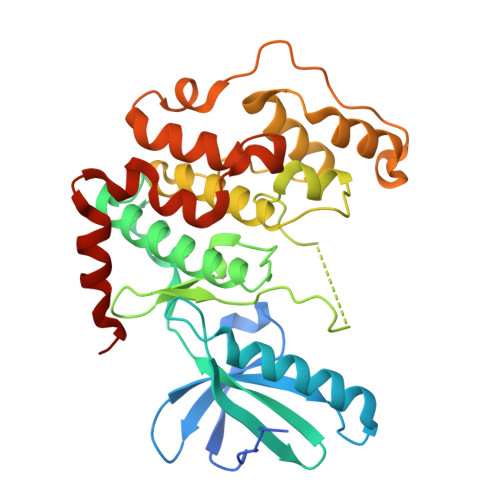Discovery and Characterization of a Chemical Probe for Cyclin-Dependent Kinase-Like 2.
Bashore, F.M., Min, S.M., Chen, X., Howell, S., Rinderle, C.H., Morel, G., Silvaroli, J.A., Wells, C.I., Bunnell, B.A., Drewry, D.H., Pabla, N.S., Ultanir, S.K., Bullock, A.N., Axtman, A.D.(2024) ACS Med Chem Lett 15: 1325-1333
- PubMed: 39140040
- DOI: https://doi.org/10.1021/acsmedchemlett.4c00219
- Primary Citation of Related Structures:
8S6I - PubMed Abstract:
Acylaminoindazole-based inhibitors of CDKL2 were identified via analyses of cell-free binding and selectivity data. Compound 9 was selected as a CDKL2 chemical probe based on its potent inhibition of CDKL2 enzymatic activity, engagement of CDKL2 in cells, and excellent kinome-wide selectivity, especially when used in cells. Compound 16 was designed as a negative control to be used alongside compound 9 in experiments to interrogate CDKL2-mediated biology. A solved cocrystal structure of compound 9 bound to CDKL2 highlighted key interactions it makes within its ATP-binding site. Inhibition of downstream phosphorylation of EB2, a CDKL2 substrate, in rat primary neurons provided evidence that engagement of CDKL2 by compound 9 in cells resulted in inhibition of its activity. When used at relevant concentrations, compound 9 does not impact the viability of rat primary neurons or certain breast cancer cells nor elicit consistent changes in the expression of proteins involved in epithelial-mesenchymal transition.
Organizational Affiliation:
Structural Genomics Consortium (SGC), UNC Eshelman School of Pharmacy, University of North Carolina at Chapel Hill, Chapel Hill, North Carolina 27599, United States.



















